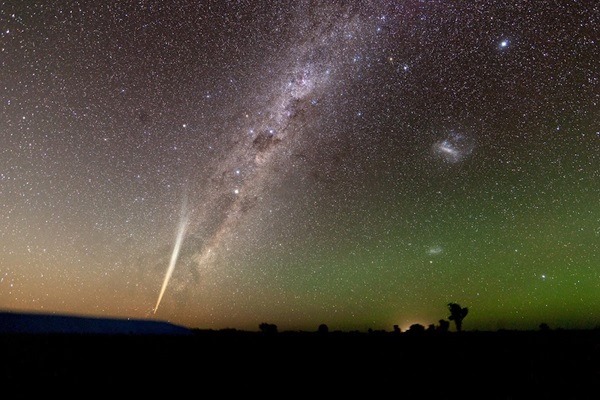This week is great for skywatchers as there will be numerous celestial sightings one could glance upon during night both with naked eye and with aid telescopes or binoculars. On July 15, our neighboring planet Venus will light up in our nighttime sky. As Moon moves 13-degrees every 24 hours, Venus will appear near the moon where the latter will act as a reference object so that people can find the planet.
Venus will appear as a brightly lit object just 2-degrees left to the moon right after sunset. Both the objects will be up high in the sky at 15-degrees west and will be clearly visible after 45 minutes after sunset. You don’t need a telescope to watch Venus glitter in the sky as it will be the most bright object alongside moon with a magnitude of -4.2 and thus, clearly visible even with naked eyes. Although you can opt for binoculars or telescopes to get a closer look. You will be able to view the planet not only in far-off rural areas but also from brightly-lit urban areas. That’s not all, because if you are lucky enough, you’ll also spot Regulus and Mercury that will be visit right above the horizon.
On July 16, you’ll need a telescope to check out the stunning Comet 21P /Giacobini-Zinner as it makes it way between 3rd magnitude Zeta Cephei and 4th magnitude Delta Cephei while zooming across the Northern Milky Way region of southern Cepheus. The comet will be visible before dawn using a telescope and witness the fiery tail that it leaves behind while gushing through space.
On July 17, Mars will appear bright in the sky and will be clearly visible throughout the week. It will rise above the horizon at 9.30p.m. local daylight time and will ascend to 30° high in the south by 2 a.m. post-midnight. It will shine with a magnitude of -2.6 and that’s what will make it brighter than other objects except for the Moon and the Venus. After 10 days, the red planet which is facing a massive global dust storm will reach its opposition position with respect to its relative position to the sun and then, it will appear 1″ bigger and 0.2 magnitudes brighter compared to previous days.
Wednesday, July 18 – It will be a great night for skywatchers as the NGC 6231 star cluster will be visible at the tail of Scorpius the Scorpion located 0.5° north of double star Zeta Scorpii that will be visible too.
Next day on July 19, the moon will move towards south-southwest direction right in the foreground of Virgo constellation. The moon will be accompanied by the stars in the Virgo constellation that will shimmer in the background. One could also spot the Jupiter located to the lower right of the moon.
Friday, July 20 – The Jupiter will glow during the nighttime sky with a magnitude of -2.2. If viewed with a telescope, one could also spot its four brightest moons that are Ganymede, Lo, Callisto, and Europa. But that’s not all because there is much more to see this month .

